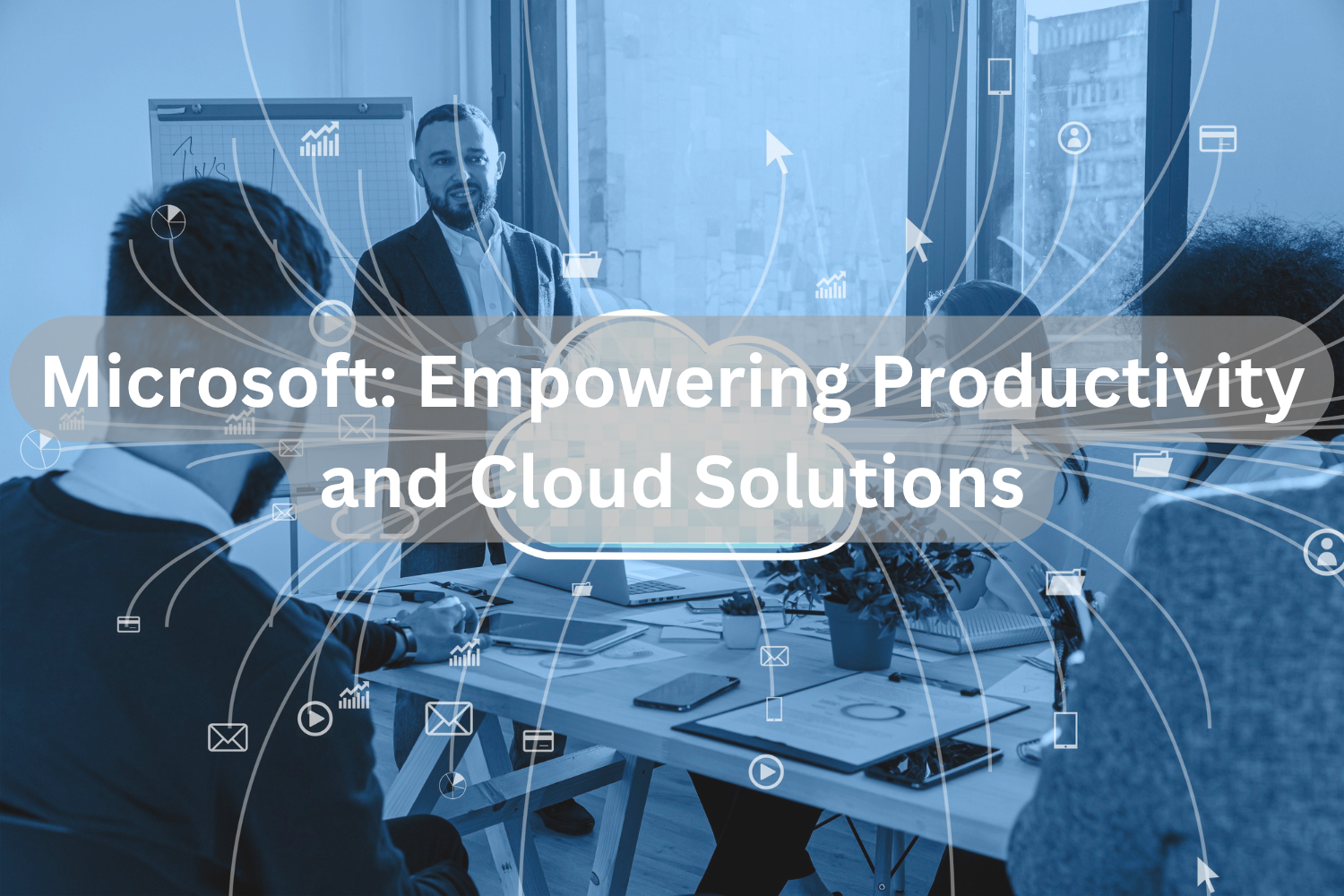Introduction
Microsoft is one of those brands, isn’t it? Let’s be honest, somehow this company has been part of life for way too long already. If you work on a school project, run a business, or manage a remote team, there are good chances Microsoft makes a few things easier for you. So, what’s behind that tech giant’s incredible success? But it’s their undeniable drive to empower productivity that delivers cutting edge cloud solutions. In this post, we’ll be going deep into some of Microsoft’s technological contributions, which we’ll talk about from the time period they started to our current and future mission advances.
A Brief History of Microsoft
Founding Days and Early Innovations
Microsoft was founded in 1975 by two childhood friends, Bill Gates and Paul Allen, who had a bold vision: to place a computer on each desk, in each home. It was their first big break, as they created an operating system called MS – DOS that was the base of the personal computing in the 1980s. Soon after, computers started to interact with people much more in their own language through the launch of Windows that made the whole thing more intuitive and more accessible.
Milestones That Shaped the Industry
Microsoft changed the world by introducing the Windows operating system in 1985 and bringing us Office in 1990, and it did so through simplicity and engineering brilliance. In 2016, LinkedIn was acquired and in 2018, GitHub as well, adding the tools used by professionals, developers and educators to its ecosystem. Microsoft is today a leader in innovation, dominating the cloud computing, AI and sustainability, to name a few.
Microsoft’s Core Productivity Tools
The Power of Microsoft Office Suite
The gold standard when it comes to the productivity software is the Microsoft Office Suite. For decades Word, Excel, PowerPoint, and Outlook have been staple tools for businesses, students and individuals.
Word: A Writer’s Best Friend
It’s not that Microsoft Word is only a word processor: It’s a powerful tool for the creation of highly precise documents. Whether you need advanced formatting options or rely on suggestions provided by an AI for professional work documents, Word is there to help you out.
Excel: The Ultimate Spreadsheet Solution
And Excel is more than just a spreadsheet app. It’s a powerhouse for financial analysts, scientists, and anyone who needs a structured way to piece together data and is able to do some data analysis, charting, and can automate them through macros.
PowerPoint: Elevating Presentations
Goodbye to your boring slides—PowerPoint turns presentations into exciting visual stories. Its templates, animations and collaboration features mean that you can be sure your ideas are noticed.
Outlook: Managing Communication Seamlessly
It isn’t just for email. This carries out calendar management, task tracking and contact collation and is an indispensable tool for professionals with many balls in the air to juggle.
Microsoft Cloud Solutions
Introduction to Microsoft Azure
Certainly, through the provision of cloud computing services, Microsoft Azure has redefined cloud computing through the provision of virtual machines, integration of AI, and IoT solutions among other services. You have a startup or global enterprise — Azure has the tools to help you innovate and scale.
Why Businesses Choose Azure Over Competitors
Scalability and Security
Azure’s intent is to grow as you do. Need more resources? Run with Azure’s flexible scaling; you will never outgrow your cloud. On top of that, its multi layer security features provide security to the data against cyber threats.
Cost-Effective Cloud Solutions
Azure’s pay-as-you-go model makes it accessible for businesses of all sizes. You only pay for the resources you use, ensuring maximum value for your investment.
Collaboration and Teamwork with Microsoft Teams
Features That Set Teams Apart
Microsoft Teams combines chat, video conferencing, file sharing and task management in one proposition. It works natively with Office apps and allows real time collaboration.
How Teams Revolutionized Remote Work
Teams became lifeline as the pandemic forced millions to work from home. Businesses were able to stay productive with the security of the secure video calls and collaboration features.
Microsoft’s Impact on Education
Tools for Students and Educators
OneNote and Teams are Microsoft Education tools that seek to make learning more interactive. They can collaborate on projects with peers, or teachers can make dynamic lesson plans and immediately offer feedback back to students.
How Microsoft Supports Hybrid Learning
Microsoft’s tools enable a seamless transition between physical and digital learning environments that perpetually change. Immersive reader and real time translation enables education to be accessible to learners of diverse backgrounds.
Advancements in Artificial Intelligence
AI-Powered Tools and Applications
Microsoft’s innovation is centered on AI. And AI from smart assistants in the Office apps to the machine learning capabilities in Azure is making everyday tasks smarter and more efficient.
The Role of AI in Productivity
Using predictive text in Word or data visualization in Excel is another flashy feature enabled by AI that saves time and reduces the number of errors. AI automates repetitive tasks so users can concentrate on unique and tactical work.
Microsoft and Digital Transformation
Empowering Businesses to Go Digital
Modernizing operations is possible through tools such as Dynamics 365 and Power BI, Microsoft helps businesses to do this. They help companies track performance, analyze trends and formulate opinions based on that.
Real-World Success Stories
Microsoft solutions are used by businesses large and our throughout the world, from small startups to multinational corporations, to innovate. So, a retail chain runs the inventory on the Azure, whereas the healthcare service provider uses the AI for diagnostics.
Microsoft’s Commitment to Sustainability
Carbon Neutral Goals
Microsoft is committed to becoming carbon negative by 2030. This means not only reducing its emissions but also removing more carbon from the atmosphere than it produces.
Innovations for a Greener Future
From building energy-efficient data centers to investing in AI tools that monitor environmental changes, Microsoft is leveraging technology to fight climate change.
The Future of Microsoft
There are many possibilities on the road ahead for Microsoft. With the advancement of AI, unwavering stance on sustainability and next generation cloud solutions, Microsoft promises to continue with the legacy of empowering individuals and businesses.
Conclusion
The company has come a long way from its old software company days to become a global innovator of productivity and cloud solutions. Its tools and technologies have become indispensable for us in both our personal and professional life, and constant improvement of innovation is what will make it one of the leaders of the tech world for years to come.
Frequently Asked Questions
Q: What makes Microsoft Azure different from other cloud platforms?
A: Azure stands out for its unmatched scalability, robust security features, and integration with Microsoft’s ecosystem of tools.
Q: How does Microsoft support small businesses?
A: Microsoft provides affordable tools like Microsoft 365, Teams, and Azure services tailored to the needs of small businesses.
Q: What tools does Microsoft offer for remote work?
A: Microsoft Teams, OneDrive, and SharePoint are among the many tools designed to enable seamless remote collaboration.
Q: How does Microsoft ensure data security in the cloud?
A: Azure employs advanced encryption, multi-factor authentication, and continuous threat monitoring to safeguard data.
Q: What are Microsoft’s plans for AI development?
A: Microsoft is investing heavily in AI, focusing on integrating machine learning into its products and developing new AI-driven solutions for various industries.





